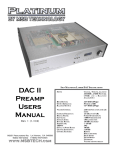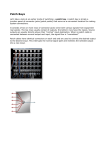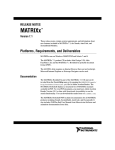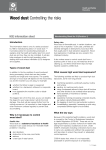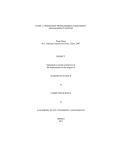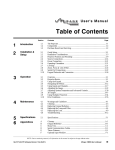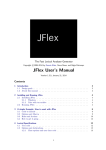Download Copper User Manual
Transcript
Copper User Manual
August Schwerdfeger
Started March 12, 2008
Contents
1
Introduction.
1.1 Copper in a nutshell. . . . . . . . . . . . . . . . . . . . . . . . . . . . . .
1.2 Example specification. . . . . . . . . . . . . . . . . . . . . . . . . . . . .
2
Copper’s parsing algorithms.
2.1 Context-aware scanning. . . . . . . . . . . .
2.2 Specification of whitespace and other layout.
2.2.1 Layout in traditional tools. . . . . . .
2.2.2 How Copper handles layout. . . . . .
2.2.3 How to specify layout in Copper. . .
2.2.3.1 Universal layout. . . . . . .
2.2.3.2 Layout per production. . .
2.3 Lexical precedence paradigm. . . . . . . . .
2.3.1 Dominate/submit-lists. . . . . . . . .
2.3.2 Disambiguation functions/groups. . .
2.4 Transparent prefixes. . . . . . . . . . . . . .
3
.
.
.
.
.
.
.
.
.
.
.
.
.
.
.
.
.
.
.
.
.
.
.
.
.
.
.
.
.
.
.
.
.
.
.
.
.
.
.
.
.
.
.
.
.
.
.
.
.
.
.
.
.
.
.
Format of grammar specifications.
3.1 Comments and whitespace. . . . . . . . . . . . . . . .
3.2 Preamble. . . . . . . . . . . . . . . . . . . . . . . . .
3.3 Parser name. . . . . . . . . . . . . . . . . . . . . . . .
3.4 Lexical syntax blocks. . . . . . . . . . . . . . . . . .
3.4.1 Terminal class declarations. . . . . . . . . . .
3.4.2 Terminal declarations. . . . . . . . . . . . . .
3.4.2.1 Semantic actions on terminals. . . .
3.4.3 Disambiguation functions/groups. . . . . . . .
3.5 Context-free syntax blocks. . . . . . . . . . . . . . . .
3.5.1 Nonterminal/start-symbol declarations. . . . .
3.5.2 Operator precedence/associativity declarations.
3.5.3 Production declarations. . . . . . . . . . . . .
3.5.3.1 Semantic actions. . . . . . . . . . .
3.6 User code blocks. . . . . . . . . . . . . . . . . . . . .
3.6.1 Auxiliary. . . . . . . . . . . . . . . . . . . . .
3.6.2 Initialization. . . . . . . . . . . . . . . . . . .
3.7 Parser attributes. . . . . . . . . . . . . . . . . . . . . .
1
.
.
.
.
.
.
.
.
.
.
.
.
.
.
.
.
.
.
.
.
.
.
.
.
.
.
.
.
.
.
.
.
.
.
.
.
.
.
.
.
.
.
.
.
.
.
.
.
.
.
.
.
.
.
.
.
.
.
.
.
.
.
.
.
.
.
.
.
.
.
.
.
.
.
.
.
.
.
.
.
.
.
.
.
.
.
.
.
.
.
.
.
.
.
.
.
.
.
.
.
.
.
.
.
.
.
.
.
.
.
.
.
.
.
.
.
.
.
.
.
.
.
.
.
.
.
.
.
.
.
.
.
.
.
.
.
.
.
.
.
.
.
.
.
.
.
.
.
.
.
.
.
.
.
.
.
.
.
.
.
.
.
.
.
.
.
.
.
.
.
.
.
.
.
.
.
.
.
.
.
.
.
.
.
.
.
.
.
.
.
.
.
.
.
.
.
.
.
.
.
.
.
.
.
.
.
.
.
.
.
.
.
.
.
.
.
.
.
.
.
.
.
.
.
.
.
.
.
.
.
.
.
.
.
.
.
.
.
.
.
.
.
.
.
.
.
.
.
.
.
.
.
3
3
3
.
.
.
.
.
.
.
.
.
.
.
7
. 7
. 7
. 7
. 8
. 8
. 8
. 9
. 9
. 10
. 10
. 11
.
.
.
.
.
.
.
.
.
.
.
.
.
.
.
.
.
12
12
12
12
12
13
13
13
14
15
15
16
16
17
17
17
18
18
.
.
.
.
.
.
.
.
.
.
.
.
.
.
.
.
.
4
5
Running Copper.
4.1 Requirements. . . . . . . . . . . . . . . . . .
4.2 Command-line. . . . . . . . . . . . . . . . .
4.2.1 Quick-start. . . . . . . . . . . . . . .
4.2.2 Switches. . . . . . . . . . . . . . . .
4.2.2.1 -q and -v. . . . . . . . . .
4.2.2.2 -runv. . . . . . . . . . .
4.2.2.3 -package. . . . . . . . .
4.2.2.4 -parser. . . . . . . . . .
4.2.2.5 -logfile. . . . . . . . .
4.2.2.6 -skin. . . . . . . . . . .
4.2.2.7 -engine. . . . . . . . . .
4.3 Copper ANT-task. . . . . . . . . . . . . . . .
4.4 Grammar troubleshooting. . . . . . . . . . .
4.4.1 Heap overflow. . . . . . . . . . . . .
4.4.2 “Conflicting definition ...” . . . . . .
4.4.3 “Contradiction involving terminals ...”
4.4.4 Parse table conflict. . . . . . . . . . .
4.4.5 Lexical ambiguity. . . . . . . . . . .
.
.
.
.
.
.
.
.
.
.
.
.
.
.
.
.
.
.
.
.
.
.
.
.
.
.
.
.
.
.
.
.
.
.
.
.
.
.
.
.
.
.
.
.
.
.
.
.
.
.
.
.
.
.
.
.
.
.
.
.
.
.
.
.
.
.
.
.
.
.
.
.
.
.
.
.
.
.
.
.
.
.
.
.
.
.
.
.
.
.
.
.
.
.
.
.
.
.
.
.
.
.
.
.
.
.
.
.
.
.
.
.
.
.
.
.
.
.
.
.
.
.
.
.
.
.
.
.
.
.
.
.
.
.
.
.
.
.
.
.
.
.
.
.
.
.
.
.
.
.
.
.
.
.
.
.
.
.
.
.
.
.
.
.
.
.
.
.
.
.
.
.
.
.
.
.
.
.
.
.
.
.
.
.
.
.
.
.
.
.
.
.
.
.
.
.
.
.
.
.
.
.
.
.
.
.
.
.
.
.
.
.
.
.
.
.
.
.
.
.
.
.
.
.
.
.
.
.
.
.
.
.
.
.
.
.
.
.
.
.
.
.
.
.
.
.
.
.
.
.
.
.
.
.
.
.
.
.
.
.
.
.
.
.
.
.
.
.
.
.
.
.
.
.
.
.
.
.
.
.
.
.
.
.
.
.
.
.
19
19
19
19
20
20
20
20
20
20
20
20
21
21
22
22
22
23
23
Running a Copper parser.
24
5.1 Requirements. . . . . . . . . . . . . . . . . . . . . . . . . . . . . . . . . . 24
5.2 Constructors. . . . . . . . . . . . . . . . . . . . . . . . . . . . . . . . . . 24
5.3 parse() methods. . . . . . . . . . . . . . . . . . . . . . . . . . . . . . . 24
A CUP skin grammar.
26
B “Mini-Java” example specification.
27
2
Chapter 1
Introduction.
1.1
Copper in a nutshell.
This manual contains instructions on how to use Copper, a Java-based LALR(1) parser
generator with expanded parsing capability compared to the Java-based CUP (http://
www2.cs.tum.edu/projects/cup/) or the C-based Bison (http://www.gnu.
org/software/bison/) .
Like CUP and Bison, Copper takes the specification of a formal grammar and generates
from it a program (specifically, a Java class) that can parse the language of that grammar.
However, unlike CUP and Bison, Copper gives you everything necessary to do so. Parsers
from most generators require an external scanner built by another tool, a scanner generator
— JLex (http://www.cs.princeton.edu/~appel/modern/java/JLex/) is
usually used with CUP and Flex (http://flex.sourceforge.net/) with Bison —
in order to work. Copper generates both the scanner and the parser from a single specification and puts them in a single Java class; this integration enables Copper to parse a larger
class of grammars than CUP or Bison.
This manual assumes a working knowledge of LR parsing; knowledge of CUP and JLex
may also be helpful.
1.2
Example specification.
Copper is designed to support several “skins,” or different formats for input, to suit a wide
range of grammar writers. There are two such skins: the “native” skin, meant for use with
machine-generated grammar specifications, and a skin mimicking the input styles of JLex
and CUP as closely as possible, meant for use by flesh-and-blood grammar writers. This
manual concerns itself exclusively with the latter skin.
Input to Copper consists, loosely, of preamble materials (package and import declarations, etc.), lexical syntax (terminal symbols and regexes used to build the scanner) and
context-free syntax (nonterminal symbols and productions used to build the parser). Optionally semantic actions may be supplied with productions and terminals.
For an example of a grammar specification written for the CUP skin of Copper, see
Algorithms 1 (no semantic actions) and 2 (with semantic actions). The parser compiled
3
Algorithm 1 Recognizer for simple arithmetic grammar.
package math;
/* This is a RECOGNIZER for a simple arithmetic
* language; it will give errors when invalid
* strings are entered, but takes no action on valid
* strings. */
%%
%parser ArithmeticParser
/* Lexical syntax */
%lex{
/* Whitespace */
ignore terminal WS ::= /[ ]*/;
/* Grammar terminals */
terminal PLUS
::= /\+/;
terminal UNARY_MINUS
::= /-/;
terminal BINARY_MINUS
::= /-/;
terminal TIMES
::= /\*/;
terminal DIVIDE
::= /\//;
terminal LPAREN
::= /\(/;
terminal RPAREN
::= /\)/;
terminal NUMBER
::= /0|([1-9][0-9]*)/;
%lex}
/* Context-free syntax */
%cf{
/* Nonterminals */
non terminal expr;
/* Start symbol */
start with expr;
/* Precedences */
precedence left PLUS, BINARY_MINUS;
precedence left TIMES, DIVIDE;
precedence left UNARY_MINUS;
expr ::=
|
|
|
|
expr PLUS expr
expr BINARY_MINUS expr
expr TIMES expr
expr DIVIDE expr
UNARY_MINUS expr
%layout ()
| LPAREN expr RPAREN
| NUMBER
;
%cf}
4
Algorithm 2 Parser for simple arithmetic grammar.
package math;
/* This is a PARSER for a simple arithmetic
* language; when run on a valid string, it
* will return the value of the expression
* represented by that string. */
%%
%parser ArithmeticParser
/* Lexical syntax */
%lex{
/* Whitespace */
ignore terminal WS ::= /[ ]*/;
/* Grammar terminals */
terminal PLUS
::= /\+/;
terminal UNARY_MINUS
::= /-/;
terminal BINARY_MINUS
::= /-/;
terminal TIMES
::= /\*/;
terminal DIVIDE
::= /\//;
terminal LPAREN
::= /\(/;
terminal RPAREN
::= /\)/;
terminal Integer NUMBER ::= /0|([1-9][0-9]*)/
{:
RESULT = Integer.parseInt(lexeme);
:};
%lex}
/* Context-free syntax */
%cf{
/* Nonterminals */
non terminal Integer expr;
/* Start symbol */
start with expr;
/* Precedences */
precedence left PLUS, BINARY_MINUS;
precedence left TIMES, DIVIDE;
precedence left UNARY_MINUS;
expr ::=
expr:l PLUS expr:r
| expr:l BINARY_MINUS expr:r
| expr:l TIMES expr:r
| expr:l DIVIDE expr:r
| UNARY_MINUS expr:e
{:
{:
{:
{:
{:
RESULT
RESULT
RESULT
RESULT
RESULT
=
=
=
=
=
l + r; :}
l - r; :}
l * r; :}
l / r; :}
-1 * e; :}
%layout ()
| LPAREN expr:e RPAREN
| NUMBER:n
;
%cf}
5
{: RESULT = e; :}
{: RESULT = n; :}
for this grammar will recognize arithmetic operations over integers, by the four arithmetic
operations as well as unary negation. Note that there are features of this specification that
would not be found in grammar specifications written for traditional tools, such as two
terminals sharing the same regex; these will be discussed in further detail below.
The structure of the rest of the manual is as follows. Chapter 2 discusses the novel
features of Copper and how to utilize them. Chapter 3 contains an exhaustive list of the
various components of a Copper specification. Chapter 4 contains information about running Copper, such as command-line syntax and how to interpret errors. Chapter 5 contains
information about utilizing the generated parser. Appendix A contains the grammar of the
CUP skin’s concrete syntax, while Appendix B contains a more elaborate example of Copper’s use in the form of a grammar for the “Mini-Java” language from Andrew Appel’s
Modern Compiler Implementation in Java.
6
Chapter 2
Copper’s parsing algorithms.
2.1
Context-aware scanning.
The most crucial difference between Copper and the standard LALR(1) parser generator is
the addition of context-aware scanning.
The typical scanner will scan through the input file and separate it into a stream of
tokens with no feedback from the parser. A scanner in Copper, by contrast, contains a
distinct sub-scanner for every state of the parser; scanner and parser work in lock-step, and
for each token a different scanner will run, scanning only for those terminals that are valid
syntax at that location.1
This enables such constructs as the two “minus” terminals in the arithmetic grammar of
Algorithm 1; UNARY_MINUS occurs before an expression, while BINARY_MINUS occurs
between expressions. However, it also requires more careful planning of lexical syntax, as
described in Sections 2.2 and 2.3.
2.2
Specification of whitespace and other layout.
2.2.1 Layout in traditional tools.
With a scanner generator such as Lex or JLex, the specification consists of a list of regexes,
optionally with semantic actions attached:
regex1 { return tok(sym.TERM1,yytext()); }
regex2 { return tok(sym.TERM2,yytext()); }
layout_regex { /* No semantic action. */ }
regex3 { ...
When the scanner runs on an input, it will check its list of regexes in downward order until
it finds one that matches the head of the input. It will then dequeue the matching part of the
input (the “lexeme,” which in Lex and JLex is stored in the variable yytext) and run the
1
If no such terminal is matched, the scanner will then scan for all terminals to procure information for an
error message.
7
semantic action associated with that regex; it will then scan again at the point in the input
immediately following that scan’s lexeme.
If the semantic action returns an object, that object (the “token”) is added to the stream
of tokens being returned to the parser. If no object is returned, the regex is judged to
represent what we call layout — parts of the input that are not supposed to be invisible to
the parser and have no meaning thereto. The most common forms of layout are whitespace
and comments.
2.2.2 How Copper handles layout.
Copper has a more sophisticated method for specifying and handling layout. While building a parser, Copper keeps track of which terminals have been designated to appear as
layout in which contexts, and builds a sub-scanner for each parser state that scans only for
the layout that is valid at that location.
Then, each time the parser calls out to the scanner for a new token, it will scan first
using the layout sub-scanner, matching many tokens of layout (series of spaces, comment
blocks, etc.) may be present. Then when no more layout is present, it will scan using the
sub-scanner for non-layout tokens.2
2.2.3 How to specify layout in Copper.
2.2.3.1
Universal layout.
The simplest sort of layout in Copper is universal layout, which should suit the needs
of most grammar writers. To designate a terminal as universal layout, simply place the
modifier ignore in front of its declaration, as is done on the terminal WS in Algorithm 1.
This has a similar effect to giving a terminal no semantic action in Lex or JLex, with the
important exception that it does not per se prevent the parser from using that terminal in a
non-layout capacity.
Any number of grammar-wide layout tokens may appear at the beginning and end of the
input. It may also appear between any two input tokens, except where explicitly specified
otherwise (see section 2.2.3.2).
N.B.: In a traditional scanner, layout is always optional, and therefore is specified as
a nonempty regex (e.g., optional whitespace might be specified as [ ]+, one or more
spaces). In Copper, layout is able to be made mandatory, and thus optional layout should
be specified as a possibly-empty regex (e.g., optional whitespace might be specified as
[ ]*, zero or more spaces).
2
Implemented in a naïve manner, this arrangement would increase the number of scans performed when
there was little to no whitespace in a file. In practice, Copper is able to scan for layout and non-layout
concurrently.
8
2.2.3.2
Layout per production.
Copper allows each production to override the grammar-wide layout and specify which
terminals may appear as layout between the strings derived from symbols on its right-hand
side.
An empty layout set may be explicitly specified, as is done on the production
expr ::= UNARY_MINUS expr in Algorithm 1. In this example, spaces are not permitted between the “negative” sign and the expression it negates (although they are permitted inside the latter).
If instead layout sets contain one or more terminals, they behave similarly to universal
layout in their designated contexts. For example, if the production expr ::= expr PLUS expr
in Algorithm 1 had a layout terminal with regex [_]+ (one or more underscores), the string
3 - 1___+__2 would be valid input, while the string 3 - 1+ 2 would not, because
the space between + and 2 is not valid layout in that context. (However, the empty string
between 1 and + is valid, because the upcoming + could as well be any other arithmetic
operator, and thus all the layout from every production representing an arithmetic operator
is valid there.)
The algorithm calculating what layout is valid where is quite a complex one, but rulesof-thumb when specifying layout are as follows:
• In any context where a terminal from the right-hand side of a certain production can
be shifted (except the leftmost one), expect the layout of that production.
• In any context where a nonterminal from the right-hand side of a certain production
can be reduced (except the rightmost one), expect the layout of that production.
• Layout specified on productions with zero or one symbols on the right-hand side is
meaningless.
For details of how to implement layout per production in Copper, see Section 3.5.3.
2.3
Lexical precedence paradigm.
It is possible for the languages of regexes to overlap, creating ambiguities in which several
regexes match a given lexeme. The most common of these is the keyword-identifier ambiguity, where a language keyword such as int also matches the regex given for identifiers.
In the operation of a scanner from a traditional scanner generator, as described above,
no ambiguities are possible because the regex list is gone through one at a time, and the
first one that matches is always used. Only if two terminals share the exact same regex is
any further kind of disambiguation possible.
Lexical precedence on terminals is here defined as a relation that determines, whenever
several terminals have a regex matching a certain lexeme, which terminal should match.
The above approach mandates a linear order on terminals: each terminal must take a place
on a line, and the terminal closest to the front of the line always matches.
9
Copper, on the other hand, allows a more generalized lexical precedence relation. Instead of putting terminals in a line, lexical precedence is specified in Copper by individual
statements of one of the following forms:
1. “Terminal x has precedence over terminal y,” or
2. “If an ambiguity occurs among terminals x, y, and z, return one of them.”
Context-aware scanning, with its many sub-scanners scanning for restricted sets of regexes,
eliminates most ambiguities and makes this scheme practical.
2.3.1 Dominate/submit-lists.
The primary sort of lexical precedence declarations used in Copper are dominate-lists and
submit-lists, specified on terminals. They implement the first sort of statements listed
above.
As the names might suggest, a terminal x’s dominate-list is a list of terminals taking
precedence over x, while x’s submit-list is a list of terminals over which x takes precedence.
Formally, x is on y’s submit-list iff y is on x’s dominate-list; however, in the actual
grammar specifications, one of these will do for both. For details of how to specify these
lists in Copper, see Section 3.4.2.
N.B.: The precedence relation created by dominate- and submit-lists is intransitive; i.e.,
if terminal x is on terminal y’s submit-list, and z on y’s, it does not follow that z is on x’s
submit-list. z must be placed on that list explicitly in such a case.
N.B.: The precedence relation created by dominate- and submit-lists is context-insensitive;
i.e., if terminal y is on terminal x’s dominate-list, then even in a sub-scanner that is scanning
for x but not y, nothing matching y will match x.
2.3.2 Disambiguation functions/groups.
The other kind of lexical precedence declarations in Copper are disambiguation functions
and disambiguation groups.
A disambiguation function is a function (a Java method, in the case of Copper’s implementation) specified for a set of terminals, to disambiguate that particular set. It is meant as
a second choice if dominate- and submit-lists do not fit the task. Disambiguation functions
implement the second sort of statements described above.
A disambiguation function works as follows: if the input to the scanner at a given point
matches the regex of more than one terminal (e.g., the group x, y, and z), and this ambiguity
is not able to be resolved through dominate- and submit-lists, the scanner will check to see
if there has been a disambiguation function for x, y, and z specified. If so, it will execute
the function, which takes in the matched lexeme and returns exactly one of x, y, and z.
One use for disambiguation functions is the “typename-identifier” ambiguity occurring
when parsing C: typenames and identifiers share a regex; if a name has been defined as
10
a type using a typedef, it is scanned as a typename, and otherwise it is scanned as an
identifier.
This ambiguity may be resolved with a disambiguation function specified for typenames and identifiers, which returns “typename” if the lexeme is on a list of typenames and
“identifier” otherwise.
A disambiguation group is a special case of the disambiguation function: instead of a
function returning a terminal, it simply specifies the terminal to return.
N.B.: Disambiguation functions and groups are context-sensitive; i.e., if there is a disambiguation group on terminals x and y specifying that terminal x should be returned, in a
context where only terminal y is valid, y will be matched.
2.4
Transparent prefixes.
The concept of a transparent prefix can best be described by example:
Suppose that in some grammar there was a terminal IntConst matching integers (regex
[0-9]+) and a terminal F loatConst matching floating-point numbers (regex [0-9]+(\.[0-9]+)?).
Clearly any number without a decimal point matches both, so there is also a disambiguation
group on the set {IntConst, F loatConst}, specifying that IntConst should be returned.
Now, in the absence of a decimal point, IntConst will be matched.
Now suppose that there must be some way for the user of the parser to indicate that a
number without a decimal point is a floating-point number. This is done using a transparent
prefix: a terminal F loatP ref ix with regex float: is defined, and assigned to be the
transparent prefix of F loatConst. Now, the integer 214 would be entered as 214, while
the floating-point 214 would be entered as float:214. The float: prefix is scanned
and thrown away like layout (the parser never sees it, hence the transparent), but unlike
layout, when it is scanned it produces a narrower context that allows F loatConst to be the
only valid terminal.
N.B.: Never use transparent prefixes to disambiguate between two terminals that are on
each other’s dominate- and submit-lists; this does not work due to context-insensitivity.
11
Chapter 3
Format of grammar specifications.
3.1
Comments and whitespace.
Java-style comments (// followed by a comment and a newline, and comments enclosed
in /* and */) are also recognized as layout in the CUP skin.
3.2
Preamble.
The preamble is a block of Java code that will begin the parser source file to be output.
It should contain any needed package or import declarations, as well as any non-public
classes to be included in the file.
The preamble is terminated by the string %% alone on a line, as shown in Algorithm 1.
3.3
Parser name.
The name of the parser class is provided by a line of the form
%parser [classname]
occurring on the line directly after the %% ending the preamble.
3.4
Lexical syntax blocks.
Lexical syntax blocks are enclosed in the markers
%lex{
and
%lex}
They may include any number of declarations of terminals, disambiguation functions, and
disambiguation groups.
12
3.4.1 Terminal class declarations.
For convenience, terminals may be formed together into (non-disjoint) sets known as terminal classes. Terminal classes are declared with a line of this form:
class tclass1[,tclass2,...];
Note that such a line only declares the classes, as opposed to specifying which terminals a
class contains. That is done in terminal declarations.
3.4.2 Terminal declarations.
The simplest terminal declaration is of this form:
terminal [termname] ::= /[regex]/;
This declares a terminal with a specified regex that is a member of no terminal classes,
does not specify any precedence relations with other terminals (although another terminal
may include it on its dominate- or submit-list), and does not have a transparent prefix or
semantic action.
A terminal declaration specifying all optional attributes is of this form:
ignore terminal [termtype] [termname] ::= /[regex]/
in ([terminal classes]), < ([submit-list]), >
([dominate-list])
{: ... :} %prefix [prefixname];
This declares a terminal that is a member of all terminal classes on the list following in,
with submit- and dominate-lists containing at least the terminals provided on the lists following < and > respectively, a semantic action returning a designated type, and a transparent prefix.
Submit- and dominate-lists may contain the names of terminal classes as well as the
names of terminals. Placing a terminal class on the list is shorthand for placing all the
members of that class on the list.
3.4.2.1
Semantic actions on terminals.
Semantic actions on terminals work differently in Copper than in other scanner generators.
While in JLex semantic actions are specified on regexes and return an object identifying
the matched terminal, as described above, in Copper the semantic action is only run after it
is certain what terminal has been matched.
Therefore, the semantic actions of terminals take on an identical format to those of
productions in CUP. A variable RESULT, of the type specified by termtype (default is
Object) is available inside the semantic action block; what is written to RESULT will be
returned and is available to access in production semantic actions.
In JLex’s semantic actions, the matching lexeme is referred to by the name yytext.
In Copper, the name lexeme is used instead.
13
Algorithm 3 Terminal declaration example.
%lex{
class keywords;
terminal INT ::= /int/
in (keywords), < (), > ();
terminal FLOAT ::= /float/
in (keywords), < (), > ();
/* Return a String: the token’s lexeme */
terminal String IDENTIFIER ::= /[a-z]+/
in (), < (keywords), > ()
{:
RESULT = lexeme;
:};
%lex}
Example. Consider a language with two keywords, INT and FLOAT, and identifiers defined as strings of one or more lowercase letters. This language is defined by the lexical
syntax block in Algorithm 3.
3.4.3 Disambiguation functions/groups.
A disambiguation function takes this form:
disambiguate [groupname]:(term1,term2[,term3,...])
{:
[body of Java method returning one of term1, term2,
...]
:};
A disambiguation group takes on this form:
disambiguate [groupname]:(term1,term2[,term3,...])
::= [one of term1, term2, ...];
Example. Consider once again the example from above. As specified there with dominateand submit-lists, INT and FLOAT are reserved keywords, i.e., they cannot be used as identifiers even in contexts where INT and FLOAT are invalid syntax.
Suppose that instead the strings int and float should only be interpreted as keywords in contexts where they are valid, and as identifiers everywhere else. Disambiguation
groups may be used to implement this, as shown in Algorithm 4.
14
Algorithm 4 Disambiguation group example.
%lex{
terminal INT ::= /int/;
terminal FLOAT ::= /float/;
terminal String IDENTIFIER ::= /[a-z]+/
{:
RESULT = lexeme;
:};
disambiguate ID_FLOAT:(FLOAT,IDENTIFIER) ::= FLOAT;
disambiguate ID_INT:(INT,IDENTIFIER) ::= INT;
%lex}
3.5
Context-free syntax blocks.
Context-free syntax blocks are enclosed in the markers
%cf{
and
%cf}
They may include one declaration of a start symbol, and any number of declarations of
nonterminals, operator precedence relations, and productions. With very few exceptions,
these take the same form as in CUP.
3.5.1 Nonterminal/start-symbol declarations.
Nonterminal declarations take the familiar form:
non terminal [nttype] ntname1[,ntname2,...];
This declares one or more grammar nonterminals. If a type (nttype) is provided, the
variable RESULT declared in the semantic action of any production with one of these nonterminals on its left-hand side will be of type nttype. If a type is not provided, the default
is Object.
The declaration of a grammar’s start symbol takes the self-explanatory form
start with [ntname];
15
3.5.2 Operator precedence/associativity declarations.
Operator precedence and associativity declarations take the familiar form:
precedence (left/right/nonassoc) term1[,term2,...];
Terminals listed on the same line have identical operator precedence, while terminals listed
on successive lines have successively higher precedence; e.g., in Algorithm 1, TIMES has a
higher precedence than PLUS, while PLUS and BINARY_MINUS have equal precedence.
All terminals on a line have the operator associativity specified on that line.
These precedences and associativities are used to resolve shift-reduce conflicts, using
the following logic:
• Operators for the shift and reduce actions are defined:
– The shift action’s operator is the terminal that would be shifted.
– The reduce action’s operator is the operator of the production that would be
reduced. This is by default the last terminal on the right-hand side of the production (e.g. + in NT ::= NT * NT + NT), but this can be overridden —
see the %prec attribute in the next section.)
• If the two operators have different precedence, resolve the conflict in favor of the
action whose operator has the highest precedence.
• If the two operators have the same precedence and the same associativity:
– If the associativity is left, resolve in favor of the reduce action.
– If the associativity is right, resolve in favor of the shift action.
– If the associativity is nonassoc, remove both actions — the operator is meant
to have its associativity defined through parentheses, or some other manner.
• Otherwise, report the conflict as unresolvable.
3.5.3 Production declarations.
Production declarations take the form:
[ntname] ::=
[sym1[:label1] ...]
{:
/* Semantic action for [ntname] ::=
RHS1 */
:}
[%prec [termname]] [%layout ([term1,..])]
16
[ | RHS2 ...
...]
;
This form is identical in most respects to that used in CUP. The declaration starts with a
nonterminal, giving the left-hand side of the productions to follow, followed by ::=. Then
come one or more sequences of zero or more terminals and nonterminals (right-hand sides),
separated by vertical bars. Each right-hand side may optionally have a semantic action and
two attributes:
• Custom operator. As in CUP, adding the attribute
%prec [termname]
to a production will change the production’s operator from the default of the last
terminal on the right, to termname.
• Custom layout. The only bit of production syntax differing from CUP’s, this allows
specification of custom layout on productions. Adding the attribute
%layout (term1,...,termn)
to a production will change the layout on that production from the universal layout
set to the set term1,...,termn.
3.5.3.1
Semantic actions.
Semantic actions on productions are identical to those in CUP. Any right-hand-side symbols
that have been labeled may be accessed inside the semantic action using the label name, as
demonstrated in Algorithm 2.
3.6
User code blocks.
3.6.1 Auxiliary.
Auxiliary code is inserted in the body of the parser class. It is meant to hold fields and
methods accessed by semantic actions and/or outside classes, such as additional constructors.
An auxiliary code block takes this form:
%aux{
[code block]
%aux}
17
3.6.2 Initialization.
Initialization code is inserted in the body of a method run when the parser is started. It is
meant to hold initializations of parser attributes.
An initialization code block takes this form:
%init{
[code block]
%init}
3.7
Parser attributes.
A parser attribute is a variable meant for use exclusively in semantic actions. Unlike fields
specified in auxiliary code, parser attributes can be accessed neither from auxiliary code
nor from outside classes.
A parser attribute is declared as follows:
%attr [attrtype] [attrname];
Both type and name are mandatory.
18
Chapter 4
Running Copper.
4.1
Requirements.
To compile a Copper parser, you need:
• Java Runtime Environment v.1.5 or greater.
• 256MB of memory (512–768 recommended if compiling large grammars).
• CopperCompiler.jar on the classpath.
4.2
Command-line.
Copper’s full command-line syntax is
java -jar [location]/CopperCompiler.jar [-q] [-v] [-runv]
[-package packagename] [-parser classname] [-logfile file]
[-skin (cup|native)] [-engine (stripped|moded)] [specfile]
> [parserfile]
4.2.1 Quick-start.
The simplest usage of Copper is
java -jar [location]/CopperCompiler.jar [specfile] > [parserfile]
This command takes a grammar specification in specfile, written in the CUP skin, and
compiles it to a parser class of the package and class name specified in the specification
itself; the source code of this parser class is then output to parserfile. The other
settings are at defaults.
19
4.2.2 Switches.
4.2.2.1
-q and -v.
By default, when running, Copper outputs a series of progress indicators to standard error,
detailing what phase of parser compilation it is in.
• The -q switch turns these off.
• The -v switch causes much debugging information — grammar descriptions, lexical
precedence graphs, state-by-state descriptions of LR DFAs, parse tables, etc. — to be
output to standard error. This switch is meant mainly for use by Copper developers.
4.2.2.2
-runv.
Compiles the parser to output debugging information when run. Meant for use in debugging
parsers.
4.2.2.3
-package.
Specifies what package the output parser should be placed in.
N.B.: Do not specify packages both on the command line and in the specification; this
will cause an error when compiling the parser source.
4.2.2.4
-parser.
Specifies what the name of the parser class should be. Overrides the name specified by a
%parser directive.
4.2.2.5
-logfile.
Specifies a file to which standard error should be redirected.
4.2.2.6
-skin.
Chooses the skin to use when reading specfile. The default is cup.
4.2.2.7
-engine.
Chooses the parsing engine (i.e. implementation of the parsing algorithm) for which the
parser should be built. Options are:
• stripped: The default. Parsers built on the stripped engine run approximately
three times slower than their CUP analogues.
• moded: Still an experimental engine: parsers run at speeds approaching that of CUP,
but in compiling and running consume much more memory than those built on the
stripped engine.
20
Task parameter
Type
compileVerbose
engine
Boolean
String
Command-line
equivalent
-v
-engine
fullClassName
String
-package,
-parser
input
Reader
None
inputLabel
String
None
inputFile
output
String
PrintStream
[specfile]
None
outputLabel
String
None
outputFile
runVerbose
skin
String
Boolean
String
[specfile]
-runv
-skin
Notes
Fully qualified name sets
package and class,
unqualified name class only.
Input source of any kind.
Name for source specified
by input (e.g. a filename).
Input file by name.
Output sink of any kind.
Name for sink specified
by output (e.g. a filename).
Output file by name.
Table 4.1: ANT-task parameters.
N.B.: There are differences between the ways the two engines handle layout, with the
following effect: The moded engine will run the semantic action on an optional (regex
matching the empty string) layout terminal only when the layout is nonempty, while the
stripped engine will run it in all cases.
For example, in the parser generated from the specification in Algorithm 1, on the input
1+2 (no spaces) the stripped engine would run five semantic actions (1, WS, +, WS, 2)
but the moded engine would run only three (1, +, 2). On the other hand, on the input 1 +
2 (with spaces) both engines would run five.
In this way the moded engine adheres most closely to the JLex convention.
4.3
Copper ANT-task.
In addition to the command-line interface, Copper provides an ANT-task, extending the
class org.apache.tools.ant.Task. See Table 4.1 for a list of the task-bean’s parameters and what switches they correspond to.
4.4
Grammar troubleshooting.
In this section, five problems encountered when compiling grammars in Copper are discussed.
21
4.4.1 Heap overflow.
The JVM is usually assigned a maximum heap size of 256MB. This is adequate for Copper
when compiling smaller grammars, but on a large one it is inadequate. Therefore, if compilation terminates with an OutOfMemoryError, add a switch to the JVM allocating
512MB or 768MB:
java -Xmx512m -jar ...
The -Xmx switch is “nonstandard and subject to change without notice.”
4.4.2 “Conflicting definition ...”
On occasion Copper will give an error of this form:
Error at [file]:line.col:
Conflicting definition involving [grammar construct]:
multiple specifications of attributes [...]
When compiling specifications in the CUP skin, this means that the same name has been
given to two constructs. The invalid duplicate construct is at the given location.
4.4.3 “Contradiction involving terminals ...”
On occasion Copper will give an error of this form:
Error at static precedence disambiguator, scanner state
...:
Contradiction involving terminals
[...,
...] on graph
...
This means that (1) there is a cyclic precedence relation among the listed terminals (i.e.
there is no way to say that one of the terminals has the maximum precedence) and (2) they
can all occur in the same context.
The precedence graph output with the contradiction gives the precedence relations
among the terminal set. A 1 in row x and column y of the graph means that terminal x
is on terminal y’s submit-list (takes precedence over y). For instance, the following graph
Vertices:
[[0: x2,
1: x3,
2: x]];
Adjacency matrix:
22
0 0 1
1 0 0
0 1 0
means that x2 is on x’s submit-list, x3 on x2’s, and x on x3’s.
4.4.4 Parse table conflict.
As in a traditional parser generator, a parse table conflict occurs when two actions are
placed in the same cell of the LR parse table; such a conflict is usually resolved by specifying precedence and associativity on terminals.
Unlike a traditional parser generator, however, Copper does not make any attempt to
resolve such conflicts automatically. Using the CUP skin, reduce-reduce conflicts are automatically resolved by the order in which conflicting productions appear in the file, as
is done in CUP. Any shift-reduce conflicts are reported as compilation errors; undefined
behavior occurs if a parser compiled from a conflicting table is run.
4.4.5 Lexical ambiguity.
Copper is able to guarantee that there is no lexical ambiguity in its scanners, if certain
compile-time checks pass. When any such checks fail, it is reported as a compilation error,
of this form:
Danger at parser states
[...]:
Lexical ambiguity (between/among) tokens:
[...,
...]
This means that the the set of terminals given are not on each other’s dominate- or submitlists, and there is no disambiguation function or group assigned to the set. There are three
ways to resolve the ambiguity:
• Modify the dominate- and submit-lists of the set of terminals;
• Add a disambiguation function or group to disambiguate the set appropriately;
• Alter the context-free syntax so this set of terminals do not appear in the same context.
23
Chapter 5
Running a Copper parser.
5.1
Requirements.
To run a Copper parser, you need:
• Java Runtime Environment v.1.5 or greater.
• CopperRuntime.jar or CopperCompiler.jar on the classpath.
5.2
Constructors.
No parameters need to be passed to a Copper parser on construction. It is possible to specify
additional constructors in the auxiliary code; however, the constructor with no parameters
cannot be specified in that manner.
5.3
parse() methods.
Each parse engine provides several methods used to run the parser:
• parse(Reader input)
• parse(Reader input,String inputLabel)
• parse(Reader input,
String inputLabel,
edu.umn.cs.melt.copper.runtime.auxiliary.ErrorReporter
reporter)
• parse(String text)
• parse(String text,String inputLabel)
• parse(String text,String inputLabel,ErrorReporter reporter)
24
Each function returns an Object that is the RESULT of the last production reduced in the
parse (i.e., the root of the parse tree), and throw exceptions java.io.IOException
and java.util.zip.DataFormatException.
The arguments to the methods are as follows.
• text is a string containing text to parse.
• input is a Reader containing text to parse.
• inputLabel (defaults to “<stdin>”) is a label for input or text, as in Table
4.1.
• reporter is the logger that will be used to log any messages or errors that are
output during the parse. This argument is only necessary when sending the text of
errors to some output sink other than standard error, and will probably be altered in
the near future; thus, for the moment it remains undocumented.
25
Appendix A
CUP skin grammar.
• Grammar of the CUP skin.
26
Appendix B
“Mini-Java” example specification.
• Appel’s “Mini-Java” grammar, specified in CUP skin.
27





























